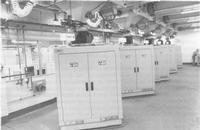


Chapter 10
I 1. Introduction
II 2. The Role Of Technology
III 3. Some Highlights Of Australian Minerals Technology
IV 4. Other Technological Achievements (in brief)
i Manganese
ii Tin
iii Tungsten
iv Tantalum
v Uranium
vi Gallium
vii Lithium
viii Silicon
ix Platinum
x Rare Earths
xi Phosphate
xii Diamonds
V 5. Export Of Technology
VI 6. Education And Research
VII 7. The Scientific Societies
VIII 8. Conclusion
References
Index
Search
Help
Contact us

Diamonds
The most spectacular accession to the mineral industries has resulted from the discovery and development of the Argyle diamond deposit in the Kimberley region of northwestern WA, which in the short space of four years has become the world's largest and richest producer of diamonds. In the first full year of production in 1986, following three years of testing and production, the project produced 29.2 M carats from 3.5 Mt of ore -an average grade of 9.7 carat/t -of which 5 per cent ranked as gem quality, including some of a unique pink colour and exceptional beauty, and a further 40 per cent as near gem quality, and the balance industrial grade. The overall yield adds about 20 per cent to the total world production and makes Argyle the largest single producer. Estimated reserves of 71 Mt of ore represent 20 years minimum life for the operation.The kimberlite, or more precisely lamproite, dyke is mined by open cut with ore : waste ratio 1: 3.5. The ore is treated by heavy media separation and sorting with the aid of X-ray induced fluorescence, producing a 99 percent diamond concentrate from the original 1.4 parts per million. The unique X-ray fluorescence technique developed by a CRA group is a most significant award winning advance. The final stage of cutting and polishing selected gems has been established in Perth.

A new pattern in respect to infrastructure has been set by the Argyle venture. Instead of setting up a complete township at the mine as has been done in the large iron ore centres in the Pilbara, the administrative and clerical staff are based in Kununurra, 200 km from the mine, and are flown in and out daily. The work force commutes from Perth, 2200 km from the mine, on a roster system of 14 days on site at Argyle and 14 days off site in Perth. The on site accommodation includes 360 single units with individual facilities and air conditioning, and community club amenities of the highest standard.
A further addition to the Australian diamond industry is projected at Bow River, downstream from Argyle, to treat alluvials amounting to 13 Mt of 0.7 carat/t grade. The project is small by Argyle standards but is designed to produce about 1 M carats/yr for 10 years or more with probably a greater proportion of gem quality than at Argyle.
The extraordinary emergence of Australia as the world's largest diamond producer adds greatly to the country's historic record in the field of gems, including opals, emeralds, sapphires, zircons, pearls, chrysoprase, nephrite jade, etc. More recently a synthetic gem industry has been established in WA to produce synthetic emeralds by a process which is claimed to be capable of producing also artificial sapphires, rubies and aquamarines. Cubic zirconia has been a very successful development in recent
years.
Organisations in Australian Science at Work - Argyle Mine, Kimberley, W.A.
 |
Australian Academy of Technological Sciences and Engineering |  |
© 1988 Print Edition pages 769 - 770, Online Edition 2000
Published by Australian Science and Technology Heritage Centre, using the Web Academic Resource Publisher
http://www.austehc.unimelb.edu.au/tia/740.html